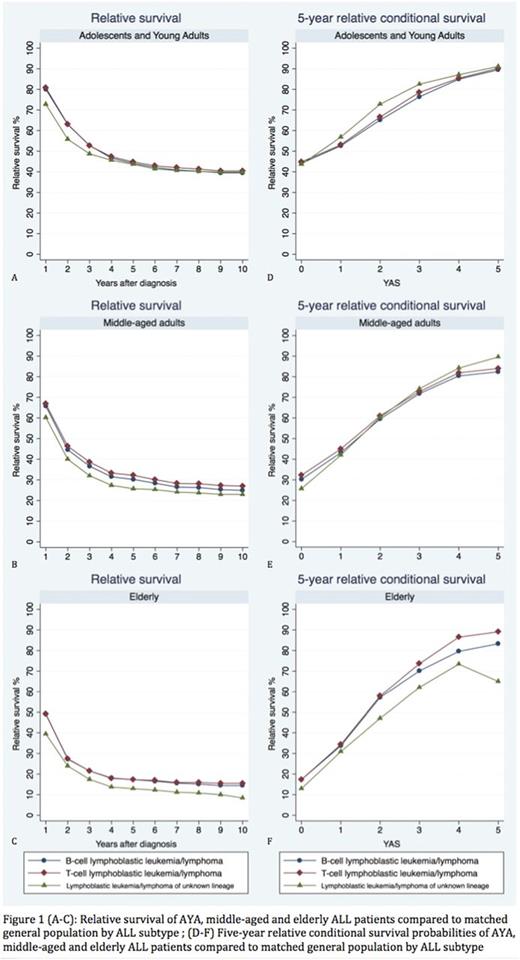Abstract
Background: Prognostic models for acute lymphocytic leukemia (ALL) patients (pts) become less meaningful and less accurate for ongoing cancer survivors. As a result, conditional survival (CS), which represents the probability that a cancer pt survives additional years (yrs), given that the pt has already survived a given number of yrs, has emerged as a more clinically relevant measure of prognosis for pts who have survived several yrs beyond diagnosis and treatment. Here we report population-level, 5-yr relative cancer survival probabilities conditional on having already survived ≥1 yr(s) after diagnosis in ALL cases diagnosed during 2000-2009, and followed through 2014.
Methods: A total of 4,553 adult ALL cases were assembled from April 2017 release of all 18 registries of the Surveillance, Epidemiology and End Results (SEER). Pts who did not receive chemotherapy in the first 3 months after diagnosis were excluded. All survival estimates reported here refer to relative survival (RS), which is survival in the pt cohort relative to the expected survival of the general population (matched for age, sex, race and calendar period over a standard follow-up time). Survival probabilities were calculated using the SEER Survival System (SEER*Stat). Trends in 5-year RS estimates conditional on already having survived 0-5 years from diagnosis were modeled using regression modeling. Estimates were adjusted for age group [adolescents and young adults (AYA) (18-39 yrs); middle-aged (40-59 yrs) and elderly (> 60 yrs)], yr of diagnosis, years already survived (YAS), sex and race. We also performed subset analyses for following ALL morphologic categories - B-cell, T-cell and ALL of unknown lineage (UL). Tests of significance were based on two-sided hypothesis at the .05 level. All analyses were performed using STATA.
Results: Figures 1A-1C show RS probability estimates for specific ALL categories by age subgroups - the 10-yr RS for T-cell ALL [40% - AYA, 27% - middle-aged, 15% - elderly], was not significantly different than that of B-cell ALL [40% - AYA, 25% - middle-aged, 14% - > 60 yrs] or ALL of UL. Overall, RS estimates were dismal for elderly age group for all three ALL categories. Figures 2D-2F illustrate the large influence of YAS on CS estimates. The estimated 5-year RS probabilities when conditioned on successive YAS increased for all age groups and for each of the ALL categories examined with the exception of ALL of UL in the > 60 age cohort. In the AYA age cohort, the CS converged to >90% in all ALL subtypes following 5 YAS. In the middle-aged cohort, the CS reached 90% in the ALL of UL subtype, 82% in the B-cell ALL subtype and 84% in the T-cell ALL subtype. Largest difference in CS estimates was seen in the elderly cohort with 5 YAS - similar for B-cell ALL and T-cell ALL (83% and 89%, respectively) but low at 65% for ALL of UL. In multivariable analyses, the 5-yr RS estimates were significantly lower in > 60 yrs cohort across all subtypes (vs. AYA, 19.09% drop (B-cell ALL) (95% CI, 18.20-19.98); 18.9% drop (T-cell ALL) (95% CI 18.12-19.68); 28.02% drop (ALL of UL) (95% CI 27.16-28.89)], males across B-cell ALL and T-cell ALL [ vs . females, 4.14% drop (B-cell ALL) (95% CI 3.75-4.52); 3.02% drop (T-cell ALL) (95% CI 2.67-3.37)], and blacks across B-cell ALL and T-cell ALL [ vs. whites, 13.35% drop (B-cell ALL) (95% CI, 12.25-14.45); 11.68% drop (T-cell ALL) (95% CI 10.86-12.50)], but showed improvement over time across all groups [2006-2009 vs 2000-2005, 12.02% improvement (B-cell ALL) (95% CI 12.35-12.89); 9.95% improvement (T-cell ALL) (95% CI 9.70-10.19); 4.81% improvement (ALL of UL) (95% CI (4.17-5.46)] and almost identical improvement with YAS across all subtypes [5 yrs vs. < 1 yr survived, 55.82% improvement (B-cell ALL) (95% CI 49.54-62.10)].
Conclusions: Following treatment completion, survival prognosis in ALL can be further refined using a population-derived, 5-yr CS estimates based on YAS. While the AYA group had the best RS estimates compared to the older age cohorts, it was still low at 40% at 10-yr mark. RS estimates were not influenced by ALL subtype. With more number of yrs survived following diagnosis and treatment, probability of survival improved for all except for elderly with ALL of UL. RS and CS information can be applied clinically at the individual level and can be used in the design of clinical trials to determine appropriate length of follow up for more accurate survival analysis.
Advani: Takeda/ Millenium: Research Funding; Pfizer: Consultancy. Gerds: Incyte: Consultancy; CTI BioPharma: Consultancy. Majhail: Sanofi: Honoraria; Anthem, Inc.: Consultancy. Sekeres: Celgene: Membership on an entity's Board of Directors or advisory committees.
Author notes
Asterisk with author names denotes non-ASH members.


This feature is available to Subscribers Only
Sign In or Create an Account Close Modal